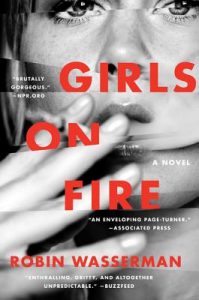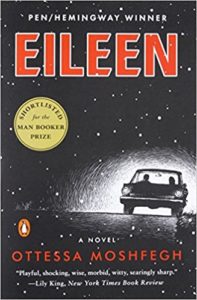I have personal reasons for being interested in toxic same-gender friendships, which is to say, I am a queer person who was a very specific kind of teenager. Many readers, and LGBT+ ones in particular, are intimately familiar with these formative young adult friendships. With both sexuality and personal identity in flux, adolescents and young adults are susceptible to love that seems to consume their very personhood—a uniquely painful tension of wanting and wanting to be, all the worse when the object of this love brings out the worst in both of them. Whether nominally platonic or overtly sexual, these destructive friendships are so all-consuming that they can only be described as romantic. At best, they leave emotional devastation in their wake. At worst—in the real world as well as in fiction—the friendship can spiral into violence.
If you’ve come out the other side of this kind of relationship, there is a certain catharsis in immersing yourself in a story about the worst-case scenario. Most such books feature homoeroticism that is subtextual rather than overt—and, interestingly, the majority of contemporary stories in this vein focus on young women rather than young men. In my own novel, These Violent Delights, I wanted both to foreground the queerness of these relationships and to explore how identity-consuming romantic obsession intersects with masculinity. But the subgenre has much to say about how young women negotiate the internal power struggles of these friendships, and it’s been fascinating to see where these stories overlap with mine and where they necessarily diverge.
These five books invite the reader to surrender again to the intoxication of a destructive relationship, and to follow it to a nightmarishly logical end.
The Secret History by Donna Tartt
A seminal exploration of identity-devouring codependency and intellectual seduction, The Secret History has inspired a fanbase as obsessive as the friendships at the book’s heart. Newly arrived at the prestigious Hampden College, Richard Papen is eager to hide his working class background and reinvent himself as a sophisticate. He quickly falls in with the insular group of students in the Classics department—they are effortlessly erudite, aristocratic in bearing if not in financial reality, and above all passionately devoted to their mental experiments. While the group’s friendship ostensibly revolves around their charismatic professor, the real center of the circle is the brilliant and eccentrically magnetic Henry Winter, who encourages the group to shut out all outside concerns in pursuit of a life of the mind. Where Henry leads, Richard and his new friends follow, with consequences that are at once inevitable and shattering. The Secret History establishes many of the thematic preoccupations of its subgenre—homoeroticism, intellectual arrogance, aspirations to class and social prestige—but it is the melancholy, autumnal tone that sets it apart. Richard’s narration is suffused with grief, and he elides as many details as he reveals, constantly trying (and often failing) to reconcile the beauty he remembers with the violence it brought forth.
Girls on Fire by Robin Wasserman
In fiction as in life, destructive same-gender friendships often follow a specific relationship dynamic. One party is insecure and submissive, and falls into the thrall of a charismatic peer who is idolized as much as loved. Girls on Fire is a classic depiction of this archetype, following the teenage friendship of bookish misfit Hannah Dexter and volatile, possessive Lacey Champlain. Lacey is everything Hannah wishes she could be, and offers Hannah a new vision of herself as cool and rebellious—even giving her an edgy nickname, Dex, which Hannah is immediately determined to deserve. Their entanglement is instant and all-consuming, and awakens dangerous traits in both girls that they would never have embraced on their own. The dynamic will be familiar to any reader who has fallen in love, platonically or otherwise, with a person they wanted desperately to become.
Eileen by Ottessa Moshfegh
A noirish and unsettling character study, Eileen is told in the wry, ruthless voice of its title character, Eileen Dunlop, a young secretary at a private boys’ prison. In many ways, Eileen is profoundly vulnerable. She is awkward, meek, disgusted by her body, trapped in a squalid home caring for her alcoholic father. But Eileen arrives in her toxic friendship with a mind already swimming with violent and perverse fantasies; her thoughts are all she can control to make her life bearable, and she embraces her internal subversiveness with relish. Her beautiful colleague Rebecca Saint John seems to detect Eileen’s hidden impulses and use them to her advantage—she initially charms Eileen with banter about bodily functions, and manipulates Eileen’s clear envy of her sexual desirability. While Eileen insists there is nothing romantic about her attraction to Rebecca, her obsession with her new friend vectors through her repressed sexual ardor as much as her fundamental loneliness. Eileen’s disturbed fantasies are spurred by her fixation on Rebecca, but they are not governed by it. She is already primed for violence; when she follows Rebecca into the book’s climactic crime, she needs only the slightest push.
Ugly Girls by Lindsay Hunter
Stories of codependent friendships often feature an element of social aspiration, with one friend yearning to adopt the other’s higher economic class, beauty, or social prestige. The relationship at the heart of Ugly Girls has no such clearly lopsided social dynamic. Both Perry and Baby Girl live in severe poverty and struggle to make friends besides each other. What unites them, in their acerbic but fiercely protective friendship, is a keen awareness of the threats posed by the outside world. They propel each other to toughness and nihilistic rebellion, but each girl is merely performing toughness, and neither has any illusions about the other’s true fragility. In the early pages Perry half-fondly thinks of Baby Girl as a “fake-ass thug,” but it becomes clear over the course of the story that Perry shares her friend’s false confidence. They desperately conceal their own frailty and show no mercy for each other’s. For all their posturing, it is this very vulnerability that propels the girls to an act of violence. Their situations are dire, their prospects bleak—and the outside threat that encroaches on their friendship is a matter of their very survival.
The Lightness by Emily Temple
“You should not, under any circumstances, expect me to be the hero of this story.” The protagonist of The Lightness, Olivia, makes it clear from the start that she is aware of her own culpability. In a narrative voice as elusive and unreliable as memory itself, The Lightness immerses the reader in a toxic obsession that its protagonist is all too eager to embrace. Early on in her stay at a therapeutic Buddhist summer school program, Olivia is pulled into the orbit of her magnetic classmate Serena, a self-styled mystic determined to achieve transcendence through human flight. Serena’s friends are acolytes as much as companions, and Olivia participates without question in the group’s increasingly esoteric endurance tests and devotionals. But Olivia’s motives are more complex than loyalty or faith. She yearns less to remake herself in Serena’s image because it would be a way of absorbing her—Olivia’s attraction to her is an unbroken synthesis of wanting and wanting to be. Her idolization of Serena is possessive and greedy, and Olivia asserts an insidious influence over her friend that throws their power dynamic into constant doubt.
***























